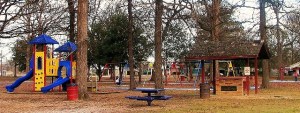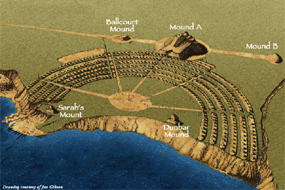Oak Grove City Park

Located at 414 James St. in Oak Grove, the City Park is one of Oak Grove’s most visited locations. The park is located on 13 acres of hardwood shaded property in the center of the city. It features two modern all children’s play grounds, a lighted 1/3 mile walking trail, four small picnic pavilions with grills, one 30’x64’ pavilion (By reservation) for large gatherings and numerous picnic tables located throughout the park.
It is also home to the Historic American Legion Hut, built during the Great Depression by the Works Progress Adminstration of hardwood logs, which is a perfect place for family reunions, receptions or any other event. It may be reserved at City Hall. There are also 30 RV hook-ups located around the Legion Hut.
The Oak Grove Jaycee’s Community Center is also located in the park and is available for rent for family reunions or other events.
West Carroll Dixie Youth Ball Park
The Ball Park is 490 Ross St. in Oak Grove and nearby to the Oak Grove City Park. Click on the link above and then click on the identifier on Google Maps. You can select the street view and browse around the park.
Established in 1956 the West Carroll Dixie Youth Ball Park is one of the finest summer league facilities in Northeast Louisiana. Located across the street from the City Park the Ball Park features six baseball/softball fields that provide summer time activities to more than 500 children age three to 19 each year. It is also site of Dixie Youth regional tournaments each July.
West Carroll Tennis Courts
The West Carroll Tennis facility is located on Hospital Road. With six lighted courts and pavilion it is the pride of the area. Membership is open to everyone for a nominal fee. The facility was developed with local volunteer labor and funding. Two area school teams use it for practicing and hosting matches. Adults have local league play and participate in USTA Team Tennis. Two open adult tournaments are held yearly. The operation of the facility is funded by membership dues and tournament fees.
Thomas Jason Lingo Community Center
Since its opening in January of 2004 the Thomas Jason Lingo Community Center has become one of the largest tourist attractions in Northeast Louisiana.
Located on Louisiana Hwy 17 less than a mile south of Oak Grove, the Lingo center is home to the Bi-Annual Northeast Louisiana Bluegrass Festival each April and October where over 1,000 bluegrass fans flock to town to experience the biggest performers in the industry. It is also home to the North Louisiana gospel weekend each March, and numerous other live events and community functions.
It features a large stage and state of the art lighting and sound. Many of its visitors have called it the nicest facility that they have visited.
It is also home of the 7-Oaks Campground with 150 complete RV Hook-Ups and Oak Grove Inn and Suites.
For more information visit www.needfoundation.com.
Poverty Point State Historic Site
North America’s largest Native American earthworks are located in south end of West Carroll Parish just east of the Village of Epps.
The site, which has been described as “the largest and most complex Late Archaic earthwork occupation and ceremonial site yet found in North America.”is a registered National Monument. Its name derives from the plantation on which the archaeological site was first rediscovered in 1873. It attracts numerous tourists.
Poverty Point is constructed entirely of earthworks. The core of the site measures approximately 500 acres (2.0 km2), although archaeological investigations have shown that the total occupation area extended for more than three miles along the river terrace. The main part of this is a group of six curving earthworks, although there are also a series of mounds both on the outside and inside of the ring earthworks.
The main part of the monument is the six concentric curving earthworks which sit in the center of the site. Each is separated from one another by a flat corridor of earth. Dividing the ridges into three sections are two ramps that slope inwardly, leading to Bayou Maçon. Each of these ridge earthworks is about three feet high.Scholars believe they were once five feet high, and were worn down through ploughing for agriculture. The approximate diameter of the outside ridge is three-quarters of a mile, while the innermost ridge’s diameter is about three-eighths of a mile.
Alongside these ridges, there are various other earthworks situated around the site. The largest of these, Mound A, is to the east of the ridges, and is roughly T-shaped when viewed from above. Many have interpreted it as being in the shape of a bird and also as an “Earth island”, representing the cosmological center of the site. Scholars use the fact that Mound A is in the center of a direct alignment between Mound B and E as an element demonstrating the complex planning exercised by the sites’ builders. In total volume, Mound A is made up of approximately 238,000 cubic meters of fill, making it the second-largest earthen mound (by volume) in eastern North America. It is second to the later Mississippian-culture Monks Mound at Cahokia, in present-day Illinois.
An interpretive museum, special events, programs and guided tours, highlight activities at the park. Tram tours are given daily at 9:30 a.m., 11 a.m., 12:30 p.m., 2 p.m. and 3:30, from March 1 through October 31.
For more information call 318-926-5492 or 888-926-5492.

